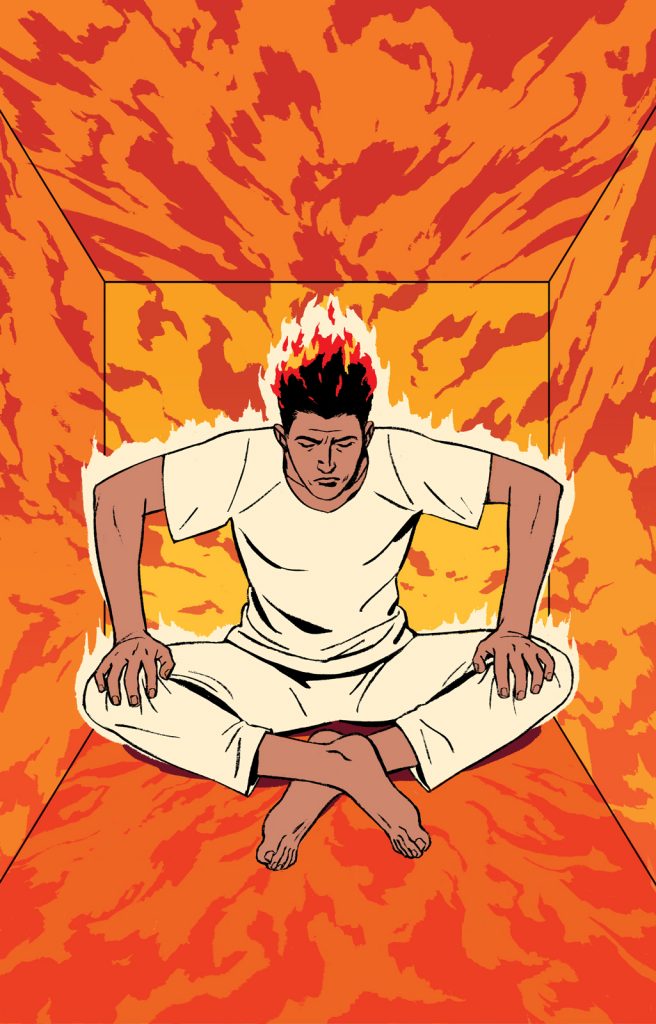“Anger is one of the densest forms of communication. It conveys more information, more quickly, than almost any other type of emotion.” This is how Charles Duhigg sums up a conversation he had with James Averill, professor emeritus of psychology at UMass, Amherst. Averill also noted that a bit of anger can quickly clear up unspoken resentments, unacknowledged boundary violations, and unaddressed imbalances. On the other hand, in Buddhism anger is often regarded as taboo, an emotional reaction to be avoided as much as possible. The 8th-century monk-scholar Shantideva, in The Way of the Bodhisattva, writes that a single moment of anger destroys the good karma built up over a thousand eons. These are two very different views, but both agree that anger is very powerful.
Is there a way to direct the energy, clarity, and power of anger to spiritual or mystical ends? Is it possible to find the peace and clarity of awareness in the experience of anger? Is it possible to use anger to put ourselves in other people’s shoes and so undermine the tendency to treat ourselves as special? Is it possible to step out of the world of conflict and opposition that anger projects? And is it possible to discover the groundlessness of experience in an emotional reaction as intense and potentially destructive as anger? Although I cannot speak for other Buddhist traditions, in the Tibetan Buddhist tradition, the answer to all these questions is an unambiguous “yes.”
For instance, Jan Willis, professor emeritus at Wesleyan, described an occasion when she was furiously angry while at Lama Yeshe’s center in Nepal. She remembers standing outside the temple fuming at something or other. Lama Yeshe crept up beside her and whispered in her ear, “Buddha mind very angry today.” Her mind stopped. The mind that is angry is the same as the mind of buddha? She had never considered that possibility. It changed everything. Anger was no longer a force or demon that took you over. It became, instead, a movement in mind, a mind as clear and empty as the sky.
In the tradition in which I trained, all experience is seen as movement in the mind. Experiences arise and fade on their own, like clouds in the sky. Anger is one such cloud, though it often arises as an overwhelming black storm cloud whose earthshaking thunderclaps deafen us to all other voices and whose flashes of lightning can set our whole world on fire. In this article, I describe four practices, each of which opens a door to a different way of experiencing anger.
Mindfulness of Anger
The first practice comes from the Vietnamese teacher Thich Nhat Hanh. I learned it years ago from Yvonne Rand, a Zen teacher associated at that time with San Francisco Zen Center. The practice is based on the Anapanasati Sutta, the “Sutra of Full Awareness of Breathing.” In this practice the breath is used as a rope: you use it to lower yourself into the experience of anger. What you find there may come as a bit of a surprise.
Start with just being in the experience of being angry. Say to yourself, “Breathing in, I feel this anger. Breathing out, I feel this anger.” No analysis, no trying to understand it, no attempt to reason your way out of it or justify it. At first, the anger may feel too hot to touch (or too cold, in the case of hatred). No matter. Touch however much you are able to, using the breath as a rope. You will probably notice physical sensations associated with anger—tightness in your stomach, for example, or constriction in your throat, or pressure in your head. You may also notice various emotional sensations, too, not just anger, but fear, perhaps, or jealousy, or sadness, or hurt. Stories will run, stories about the anger or about who or what made you angry. Again, using the breath as a rope to hold onto, just let all those reactions to the anger swirl around and in you like autumn leaves in the wind. While you are doing this, you might say to yourself, “Breathing in, I feel reactions to this anger. Breathing out, I feel reactions to this anger.”
Something strange often happens at this point. You may find that you can feel the anger and how your whole system reacts to it and not be carried away in the storm. You discover that you can feel the anger and be calm at the same time. Now you say to yourself, “Breathing in, I feel calm in this anger. Breathing out, I feel calm in this anger.” Then you discover that it is possible to relax in the anger, to be at ease in it. To bring out that possibility, you might say, “Breathing in, I am at ease in this anger. Breathing out, I am at ease in this anger.”
“Breathing in, I feel calm in this anger. Breathing out, I feel calm in this anger.”
At this point, you have to be a little careful. When you start to relax in the anger, you will feel everything that you have felt before more clearly and more intensely. You may wonder if something is wrong. Isn’t the anger meant to go away? In fact, nothing is wrong. You are just experiencing what is going on in you more completely. You may need to cycle back to one or another of the earlier stages, but there is no problem with this. A common misconception is that practice proceeds in a linear progression, but it doesn’t. There are many ups and downs. Meanwhile, you are discovering a new possibility—namely, that you can experience anger without tensing against it—and you are beginning to explore that possibility.
Somewhere in this process, you may suddenly become aware that your relationship with the anger has shifted. You know what it is, and it doesn’t intimidate or disturb you. For the moment at least, you are free from the tyranny of reaction. Now you might say, “Breathing in, I know this anger. Breathing out, I know this anger.”
And that’s it. Using the breath as a rope, you have lowered yourself into the experience of anger and discovered the possibility of peace and clarity there, not by controlling the anger or trying to get rid of it, but by opening to the anger and experiencing it completely.
One final point. This is not a one-shot exercise. This is a practice. You do it again and again, until it becomes part of you. Then you keep doing it, and the practice starts to work on you. That is when real understanding begins to ripen. Furthermore, as you gain facility, you may find that when anger arises during the day, at work or at home, you can open to it and touch that peace and clarity in the moment.
Taking and Sending
A second method for working with anger or other difficult emotions is taking and sending, one of the key practices in the Mahayana mind-training tradition of Tibetan Buddhism.
If you are consumed by anger, consider everyone in the world who is experiencing anger right now. It doesn’t matter what you are angry about, or what they are angry about. It is enough that you are angry and they are angry. As you breathe in, imagine their anger coming into you through your nostrils and down into your heart in the form of thick black smoke. Imagine, too, that everyone in the world except you is now free of anger. Experience everyone’s anger for them! As you breathe out, imagine that all the joy and peace you’ve experienced in your life goes out to everyone. The joy and peace arise in your heart, and go out your nostrils like silvery moonlight, going to every being in the world and filling each one with joy, peace, and well-being. Give all your joy and well-being away!
Don’t force this practice. Don’t hurry it, either. There is plenty of anger out there. Just take it in, breath by breath. Connect with your own joy and peace. There is plenty of that, too. Give it all away, breath by breath.
Keep it simple with the black smoke coming in and the silver light going out, reminding yourself every few breaths what you are taking in and sending out. Don’t exert a lot of effort trying to track exactly what you are taking in or sending out. Let the symbolism of black smoke and silver light work their magic. Just do it, without expectation or anxiety.
Related: “Tonglen on the Spot“
You are not transforming the anger into peace and joy, and then sending that back out to others. Some people have been told to do taking and sending this way. There may be other practices in which you imagine such a transformation, but they are not taking and sending.
Don’t force this practice. Don’t hurry it, either. There is plenty of anger out there.
In the beginning, people often say that they don’t feel much of anything when they do this practice. That is not unusual. As you become accustomed to this exchange, however, you will feel more and more the negativity and suffering coming into you and more and more how you can give peace, joy and well-being and everything that you value in life to others. Your effort is to let taking and sending work on you by letting the exchange strip away everything that you have ever hoped or longed for, and then strip away the hope and the longing, too.
Taking and sending is a very effective way of breaking the spell of anger and other strong emotional reactions. If, however, you do this practice to help yourself feel better in difficult situations, you are, unfortunately, corrupting the practice. Inadvertently, perhaps, you are reinforcing your sense of self. The aim of taking and sending is twofold: to break the spell of emotional reactions and to move beyond self-interest. Thus you just take in the anger and give away your joy. Over time this practice brings about a fundamental rewiring of your whole being.
Emptying the Hell Realm
The third practice is drawn from deity practice, one of the principal methods of Vajrayana in Tibetan Buddhism. The purpose of this practice is to instill the experiential understanding that how you see the world when you are possessed by anger has no underlying reality. You see the world as if under a spell, and the spell can be broken.
Vajrayana practice assumes that you have the capacity to know that you are angry. If you are not even aware that you are angry when you are angry (and more than a few people are not), you cannot do this practice. At best, it will be just an intellectual exercise. At worst, it will reinforce your anger and you will become a monster. Instead, do either of the previous two methods, both of which build the ability to know when you are angry.
To begin this practice, acknowledge that you are angry. You are in hell. You see the world in terms of conflict and opposition. You see everything as a struggle, as a fight to the death. An intolerable surge of molten fury is trying to burst out and incinerate anything and everything that might oppose you. It is as if a flaming spear has pierced you from head to toe and is burning you from the inside out. You feel you have to fight just to survive, and everyone and everything is against you. Even if you can control the impulse to lash out to protect yourself, you seethe inside.
Turn to that place in you that knows you are angry. What knows you are angry is itself not angry. Connect with that part of you and let the spirit of awakened compassion come into you. Let yourself be taken over by the energy or spirit of awakened mind. That spirit is often imagined as Avalokiteshvara or White Tara, embodiments of awakened compassion. Feel that you are the embodiment of awakened compassion and that you have infinite resources of wisdom, compassion, patience, and power.
Infused with the spirit of awakened compassion, your body fills with light, and the light radiates all through the hell realm. It permeates your own body and touches each and every being, instantly dissolving all pain and injury and replacing the crash and clash of conflict with peace and joy. Light continues to radiate from you until the whole hell realm and all the beings there dissolve into a light of even greater intensity. That light comes back into you, and you become light. And there you rest. After a few moments, your ordinary sense of self returns, but there is a difference. Something of the spirit of awakened compassion returns, too.
This practice is a form of magic. You are using intention, symbolism, and ritual to change how you experience life. We often think of magic as working instantly, but magic works over time as power and energy accumulate in intention and ritual. Therefore, do this practice again and again. Through repetition, it will inform your life in ways that are often unexpected and unanticipated. This is how magic works.
Groundless Experience
The fourth practice is drawn from the direct-awareness traditions of Tibetan Buddhism. This particular instruction is from the Dzogchen tradition, but you will find similar instructions in the Mahamudra tradition.
In this practice, you are going to use the energy of anger to power attention. Basically, for practice purposes the angrier you are, the better. However, there is a definite danger here. If you cannot stay in the experience of anger without being consumed by it, you will inevitably fall under its spell and risk serious damage—to other people and to your life.
You are angry. That is all you need. What gives rise to your anger is irrelevant to this practice.
Let mind and body settle for a few moments. Then look right at the anger. What is the anger made of? What makes the anger? What produces it? You are not looking for psychological, neurological, scientific, or rational explanations. Those are all beside the point. You are looking for what in you actually generates the anger. Again, not what makes you angry, but what makes the anger.

When you look right at what makes the anger, you probably won’t see anything. Right at that moment, you may not feel angry at all, and then you may fall into a kind of confusion. If that happens, then bring back the anger. Replay the circumstances or the issue that stirred you up, and then look again at what is making the anger you experience. Look for short periods, just a few seconds initially, but look intensely. Feel the anger and let the anger fuel your looking.
When you look, you will probably not see anything. You are not necessarily doing anything wrong. Keep going, looking again and again. You are learning how to let the energy of anger flow into attention. Feel the anger, look at what is making the anger right in that moment, and let the energy of anger pour into your attention and your looking, as if you are riding a rocket going straight into the sun. Again, do this for short periods, and then rest. It is an intense practice and will demand everything of you. At some point, the not seeing anything shifts, and you see.
Not seeing anything is a kind of blankness. When you do just see, you are completely awake and clear. As the 19th-century Nyingma master and mystic Ju Mipham writes, “You experience an awareness that is free from thought and movement, has no sense of inside or outside, and is utterly clear and transparent, like space.”
The first time this happens will probably be a bit disorienting, as it is a startling clarity and knowing that has no conceptual content whatsoever. Don’t make anything of it. Just let it soak into you. When it passes, don’t try to duplicate or replicate the experience. Nothing is ever the same the second time, because you are different. Just keep doing the practice and, like the other practices, let this practice work on you.
Conclusion
Here I’ve presented four different methods of practice. Any one of them is sufficient for discovering the possibility of being awake in anger, or any other emotional reaction. But they do differ in what they do, what you need in order to practice them, and what result they bring about.
The first practice, in which you lower yourself into the emotional reaction using the breath as a rope, answers the question “Is it possible to find peace and clarity in the experience of anger itself?” The answer is yes. You find that peace and clarity in the storm of anger itself. It is not an intellectual exercise. To do this practice, you do need a quiet consistency in effort. Over time, the practice itself develops your capacity to experience anger without being consumed by it. When you do find that peace and clarity, you also discover how anger is transformed into attention and awareness. Here, transformation is not something you do but something that happens when the condition are right.
Related: “Soothing the Hot Coals of Rage“
The second practice, taking and sending, undermines our sense of being special and the associated tendency of self-cherishing, the view that we somehow deserve special consideration. You come to understand, experientially, that you are no different from any other human being. One of the side effects is that you see how untenable any form of prejudice and discrimination is, whether based on race, gender, political ideology, or socio-economic status. In order to do this practice, you need to have a solid relationship with compassion. In particular, you need to be willing to experience the pain of the world. As my teacher once said, “If you could really take away all the suffering of the world by breathing it in in a single breath, would you hesitate?” If you don’t feel this way, this practice is not for you. The principal result of this practice is that our sense of self, our identity as being this or that, evaporates like mist in the morning sun. We know that we are not special and not different from others, because the way we struggle in our lives is not different, fundamentally, from the way others struggle in theirs.
The projected world of anger is like a bad dream that has somehow taken us over.
In the third practice you connect with the spirit of awakened compassion and radiate the energy of that compassion in the form of light. The higher level of energy empties the hell realm, the world projected by anger. In order to do this practice, you need to be willing to enter hell, to experience your own anger and hatred and at the same time know the quiet place in you that just knows. This practice reveals that the projected world of anger is like a bad dream that has somehow taken us over. We discover the possibility of being awake, even in this bad dream. Then when anger does arise in our lives, we are less likely to believe our projections and more likely to know them for the phantoms they are. That experiential knowing is freedom.
Finally, in the fourth practice you use the energy of anger to go right through the experience of anger to see what anger really is. To do this practice, you need to have sufficient attention to stay present in the sustained experience of intense anger. This is no small matter, and it is no picnic, either. As you build skill and capacity in this practice, you are increasingly able to touch the groundlessness of being. The more you do so, the more you are able to let go of the crutch of rationality and reason and trust the clear, empty, immediate, and responsive nonconceptual knowing that arises whenever you touch that groundlessness.
The practices discussed here are qualitatively different from how spiritual practice is often presented these days. They are not intended as quick fixes, ways to hack your mind or your life, or as practices to help you in a difficult situation, to feel better when you are down, or to work through a problem in your life. All those are possible side effects. The practices themselves are designed to bring about fundamental changes in how you experience life. While you may learn how to do them in a matter of days, you will probably notice how the practices are working on you only after at least six to eight months of consistent practice, with the real changes typically coming over the course of years. More than a few people have deep insights soon after beginning a new practice. However, those insights are usually a result of energy surges, releases of energy from emotional patterns that have been locked up for a long time. Those insights are rarely stable and soon dissipate because the mind-body system is still configured to react rather than respond.
Through consistent effort, however, you may uncover a kind of compassion that enables you to see the destructiveness of suffering, however it arises. This understanding will enable you to see through cultural prejudices and to see all people, regardless of political, social, or cultural identity, not as “other” but as human beings who, like you and me, are struggling to make the best of their lives. You may also discover a different way of experiencing life, a way that does not depend on the conceptual or the rational mind, but puts you directly in touch with the great mystery of being.
Thank you for subscribing to Tricycle! As a nonprofit, we depend on readers like you to keep Buddhist teachings and practices widely available.


